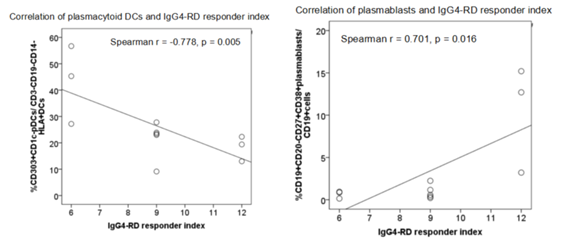Session Information
Session Type: Abstract Submissions (ACR)
Background/Purpose
Immunoglobulin (Ig) G4-related disease (IgG4-RD) is a recently recognized fibro-inflammatory disease with multi-organ system involvement. Affected patients frequently have a history of bronchial asthma and allergic rhinitis. The reported pathogenesis of IgG4-RD describes the clear involvement of excessive Th2 cells and regulatory immune reaction in addition to plasma cells 1). However, peripheral immune cell phenotype, which reflects disease status, has not been comprehensively evaluated. Our aim was to definitively determine peripheral blood cell abnormalities and their correlation with disease activity in patients with IgG4-RD.
Methods
Peripheral blood samples were obtained from active untreated IgG4-RD patients (n=11) and healthy controls (n=16). Comprehensive immunophenotyping assay with information on activation status was done by multi-color flow cytometry, and the proportion of peripheral blood mononuclear cells (PBMCs), including T cells (naïve/memory, Th1/2/17, Treg, and Tfh), B cells (naïve/memory, plasmablast, Breg), monocytes (classical, intermediate, non-classical) and dendritic cells (myeloid, plasmacytoid), and their activity status were precisely defined. Disease activity was measured using the IgG4-RD responder index (RI). Statistical analysis was done using the Mann-Whitney U test and Spearman rank correlation coefficient test.
Results
The proportion of plasmablasts (CD19+CD20-CD27+CD38+), memory Th2 cells (CD3+CD4+CXCR3-CCR6-CD45RA-), Tregs (CD3+CD4+CD25+CD127low), Tfh (CD3+CD4+CXCR5+), and mDCs (CD3-CD19-CD14-HLA-DR+CD1c+CD303-) in peripheral blood was significantly increased in IgG4-RD patients compared with HC, whereas the proportion of pDCs (CD3-CD19-CD14-HLA-DR+CD1c-CD303+)was significantly decreased. Interestingly, the proportion of pDCs in total DCs was negatively correlated with IgG4-RD RI (r=-0.778, p=0.005) while the proportion of plasmablasts in CD19+cells was positively correlated with RI (r=0.701, p=0.016). Further, the increased proportion of plasmablasts was positively correlated with serum IgG4 level (r=0.718, p=0.013) while the decreased proportion of pDCs tended to be negatively correlated with the number of affected organs (r=-0.518, p=0.061).
Conclusion
Our comprehensive analysis identified distinct proportional changes in PBMCs in IgG4-RD. In particular, the decrease in pDCs and increase in plasmablasts were strongly linked with disease activity. These combined measurements are expected to be clinically useful surrogate cell markers. This newly identified decrease in circulating pDCs may be involved in the pathogenesis in IgG4-RD via the recently described role in the enhancement of Th2 response 2).
References: 1) Stone JH et.al. N Engl J Med 2012;366:539-51
2) Maazi H et.al. Allergy 2013;68:695-701
Disclosure:
M. Akiyama,
None;
K. Suzuki,
None;
Y. Kassai,
Employee of Takeda Pharmaceutical Company Limited,
3;
T. Miyazaki,
Employee of Takeda Pharmaceutical Company Limited,
3;
R. Morita,
None;
A. Yoshimura,
None;
T. Takeuchi,
Grant/research support: Abbott Japan Co., Ltd., Astellas Pharma, Bristol–Myers K.K., Chugai Pharmaceutical Co, Ltd., Daiichi Sankyo Co., Ltd., Eisai Co., Ltd., Janssen Pharmaceutical K.K., Mitsubishi Tanabe Pharma Co., Pfizer Japan Inc., Sanofi–Aventis K,
2.
« Back to 2014 ACR/ARHP Annual Meeting
ACR Meeting Abstracts - https://acrabstracts.org/abstract/proportion-of-peripheral-plasmacytoid-dendritic-cells-and-plasmablasts-reflects-disease-activity-in-igg4-related-disease/

